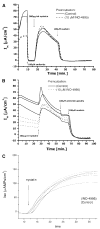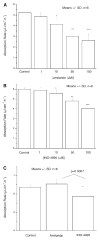Inositol polyphosphate derivative inhibits Na+ transport and improves fluid dynamics in cystic fibrosis airway epithelia
- PMID: 15857902
- PMCID: PMC1800890
- DOI: 10.1152/ajpcell.00591.2004
Inositol polyphosphate derivative inhibits Na+ transport and improves fluid dynamics in cystic fibrosis airway epithelia
Abstract
Amiloride-sensitive, epithelial Na(+) channel (ENaC)-mediated, active absorption of Na(+) is elevated in the airway epithelium of cystic fibrosis (CF) patients, resulting in excess fluid removal from the airway lumen. This excess fluid/volume absorption corresponds to CF transmembrane regulator-linked defects in ENaC regulation, resulting in the reduced mucociliary clearance found in CF airways. Herein we show that INO-4995, a synthetic analog of the intracellular signaling molecule, D-myo-inositol 3,4,5,6-tetrakisphosphate, inhibits Na(+) and fluid absorption across CF airway epithelia, thus alleviating this critical pathology. This conclusion was based on electrophysiological studies, fluid absorption, and (22)Na(+) flux measurements in CF airway epithelia, contrasted with normal epithelia, and on electrophysiological studies in Madin-Darby canine kidney cells and 3T3 cells overexpressing ENaC. The effects of INO-4995 were long-lasting, dose-dependent, and more pronounced in epithelia from CF patients vs. controls. These findings support preclinical development of INO-4995 for CF treatment and demonstrate for the first time the therapeutic potential of inositol polyphosphate derivatives.
Figures





Similar articles
-
INO-4995 therapeutic efficacy is enhanced with repeat dosing in cystic fibrosis knockout mice and human epithelia.Am J Respir Cell Mol Biol. 2010 Jan;42(1):105-12. doi: 10.1165/rcmb.2008-0380OC. Epub 2009 Apr 3. Am J Respir Cell Mol Biol. 2010. PMID: 19346319 Free PMC article.
-
Altered fluid transport across airway epithelium in cystic fibrosis.Science. 1993 Oct 15;262(5132):424-7. doi: 10.1126/science.8211164. Science. 1993. PMID: 8211164
-
Ursodeoxycholic acid inhibits ENaC and Na/K pump activity to restore airway surface liquid height in cystic fibrosis bronchial epithelial cells.Steroids. 2019 Nov;151:108461. doi: 10.1016/j.steroids.2019.108461. Epub 2019 Jul 22. Steroids. 2019. PMID: 31344409
-
Pharmacotherapy of the ion transport defect in cystic fibrosis: role of purinergic receptor agonists and other potential therapeutics.Am J Respir Med. 2003;2(4):299-309. doi: 10.1007/BF03256658. Am J Respir Med. 2003. PMID: 14719996 Review.
-
ENaC inhibitors and airway re-hydration in cystic fibrosis: state of the art.Curr Mol Pharmacol. 2013 Mar;6(1):3-12. doi: 10.2174/18744672112059990025. Curr Mol Pharmacol. 2013. PMID: 23547930 Review.
Cited by
-
Cystic fibrosis transmembrane conductance regulator modulators for personalized drug treatment of cystic fibrosis: progress to date.Drugs. 2010 Feb 12;70(3):241-59. doi: 10.2165/11316160-000000000-00000. Drugs. 2010. PMID: 20166764 Review.
-
TMEM16A in Cystic Fibrosis: Activating or Inhibiting?Front Pharmacol. 2019 Jan 29;10:3. doi: 10.3389/fphar.2019.00003. eCollection 2019. Front Pharmacol. 2019. PMID: 30761000 Free PMC article. Review.
-
INO-4995 therapeutic efficacy is enhanced with repeat dosing in cystic fibrosis knockout mice and human epithelia.Am J Respir Cell Mol Biol. 2010 Jan;42(1):105-12. doi: 10.1165/rcmb.2008-0380OC. Epub 2009 Apr 3. Am J Respir Cell Mol Biol. 2010. PMID: 19346319 Free PMC article.
-
Cystic Fibrosis: The Mechanisms of Pathogenesis of an Inherited Lung Disorder.Drug Discov Today Dis Mech. 2007;4(2):63-72. doi: 10.1016/j.ddmec.2007.09.001. Drug Discov Today Dis Mech. 2007. PMID: 18560471 Free PMC article.
-
Control of TMEM16A by INO-4995 and other inositolphosphates.Br J Pharmacol. 2013 Jan;168(1):253-65. doi: 10.1111/j.1476-5381.2012.02193.x. Br J Pharmacol. 2013. PMID: 22946960 Free PMC article.
References
-
- Blazer-Yost BL, Paunescu TG, Helman SI, Lee KD, Vlahos CJ. Phosphoinositide 3-kinase is required for aldosterone-regulated sodium reabsorption. Am J Physiol Cell Physiol. 1999;277:C531–C536. - PubMed
-
- Burch LH, Talbot CR, Knowles MR, Canessa CM, Rossier BC, Boucher RC. Relative expression of the human epithelial Na+ channel subunits in normal and cystic fibrosis airways. Am J Physiol Cell Physiol. 1995;269:C511–C518. - PubMed
-
- Caldwell RA, Boucher RC, Stutts MJ. Neutrophil elastase activates near-silent epithelial Na+ channels and increases airway epithelial Na+ transport. Am J Physiol Lung Cell Mol Physiol. 2005;288:L813–L819. - PubMed
-
- Caldwell RA, Boucher RC, Stutts MJ. Serine protease activation of near-silent epithelial Na+ channels. Am J Physiol Cell Physiol. 2004;286:C190–C194. - PubMed
-
- Carew MA, Yang X, Schultz C, Shears SB. Myo-inositol 3,4,5,6-tetrakisphosphate inhibits an apical calcium-activated chloride conductance in polarized monolayers of a cystic fibrosis cell line. J Biol Chem. 2000;275:26906–26913. - PubMed
Publication types
MeSH terms
Substances
Grants and funding
LinkOut - more resources
Full Text Sources
Other Literature Sources
Medical

